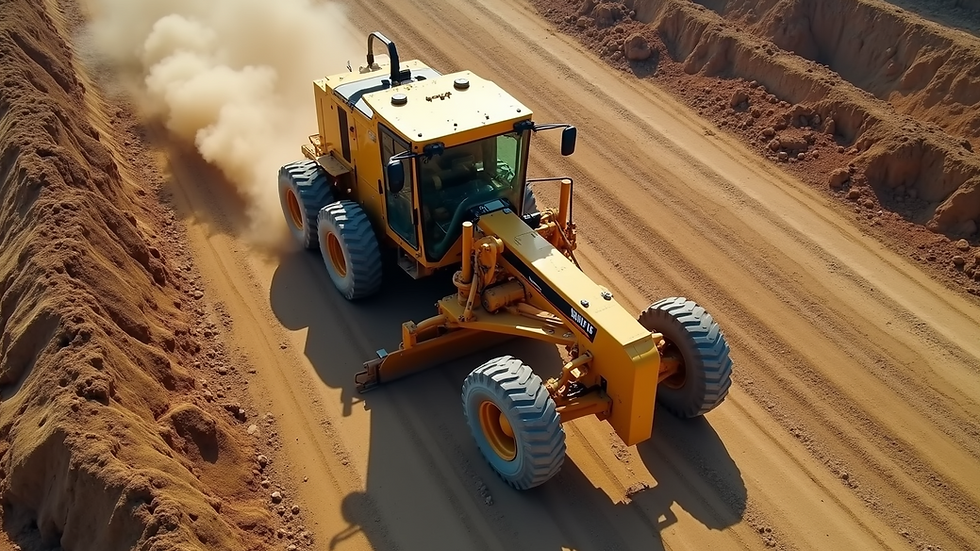The Importance of Dirt Work in Construction
- Christian Klein
- Oct 1
- 4 min read
In construction, the foundation of any successful project starts with precise groundwork. Grading and land leveling are critical steps that set the stage for everything that follows. Without proper preparation, structures can face serious issues such as uneven settling, drainage problems, and costly repairs. I have seen firsthand how meticulous site preparation can make or break a project. This post will explore why grading and land leveling are essential, what they involve, and how they contribute to long-lasting, stable construction.

Why Grading and Land Leveling Matter
Grading and land leveling are the processes of shaping the land to create a flat or sloped surface that meets the design requirements of a construction project. These steps are not just about aesthetics; they are about safety, durability, and functionality.
Drainage Control: Proper grading ensures water flows away from buildings, preventing flooding and water damage.
Foundation Stability: A level base reduces the risk of foundation cracks and uneven settling.
Accessibility: Smooth, even surfaces make it easier to build roads, sidewalks, and driveways.
Compliance: Many local building codes require specific grading standards to protect the environment and neighboring properties.
In Treasure Valley and surrounding areas, where soil types and weather conditions vary, precise grading and land leveling are even more critical. The right approach can prevent erosion and maintain the integrity of the site over time.
The Process of Grading and Land Leveling
Grading and land leveling involve several key steps, each requiring skill and attention to detail.
Site Assessment: Surveyors and engineers evaluate the land’s current condition, soil type, and drainage patterns.
Planning: A grading plan is developed to meet project specifications and local regulations.
Clearing and Excavation: Vegetation, rocks, and debris are removed to prepare the site.
Cut and Fill: Soil is either removed (cut) or added (fill) to achieve the desired elevation and slope.
Compaction: The soil is compacted to increase stability and prevent future settling.
Final Grading: The surface is smoothed and shaped to exact specifications.
Each step requires specialized equipment and experienced operators. Mistakes at any stage can lead to costly delays and repairs.

What does dirt work stand for?
The term "dirt work" refers to the broad range of earthmoving activities involved in preparing a construction site. This includes excavation, grading, land leveling, trenching, and backfilling. Essentially, it covers all the tasks that involve moving and shaping soil and rock to create a stable base for construction.
Dirt work is foundational. It ensures that the site is ready for concrete pouring, utility installation, and building construction. Without proper dirt work, projects risk structural failures and increased maintenance costs.
For example, when preparing a site for a new commercial building, dirt work involves removing unsuitable soil, grading the land to direct water away from the foundation, and compacting the soil to support heavy loads. This preparation is crucial for the longevity and safety of the structure.
If you want to learn more about how dirt work supports concrete preparation, check out this resource: dirt work.
Tools and Techniques Used in Grading and Land Leveling
Modern construction relies on advanced tools and techniques to achieve precise grading and land leveling.
Bulldozers: Used for rough grading and moving large amounts of soil.
Excavators: Ideal for digging trenches and removing debris.
Motor Graders: Provide fine grading and create smooth, even surfaces.
Compactors: Increase soil density to prevent settling.
Laser Levels and GPS: Ensure accuracy in elevation and slope measurements.
Using these tools correctly requires expertise. Operators must understand soil behavior, equipment capabilities, and project specifications. This expertise ensures the site is prepared efficiently and to the highest standards.
In Treasure Valley and Valley County, where terrain can be uneven and soil conditions vary, employing the right equipment and techniques is essential. It minimizes environmental impact and maximizes project success.

Long-Term Benefits of Proper Grading and Land Leveling
Investing time and resources into proper grading and land leveling pays off in the long run. Here are some benefits:
Reduced Maintenance Costs: Proper drainage and stable soil reduce the need for repairs.
Increased Property Value: Well-prepared land enhances curb appeal and usability.
Improved Safety: Stable ground reduces risks of accidents and structural failures.
Environmental Protection: Controlled water flow prevents erosion and protects nearby ecosystems.
For developers and contractors, these benefits translate into smoother project execution and satisfied clients. For property owners, it means peace of mind and a solid investment.
Final Thoughts on Site Preparation Excellence
Site preparation is the backbone of any construction project. Grading and land leveling are not optional steps; they are essential for success. Precision, experience, and the right equipment make all the difference.
Choosing a trusted partner who understands the unique challenges of the Treasure Valley and Valley County region ensures your project starts on the right foot. Quality dirt work leads to quality construction. It’s that simple!
By prioritizing these foundational steps, you set your project up for durability, safety, and long-term value. Don’t overlook the power of proper grading and land leveling. It’s the first step toward building something great.




Comments